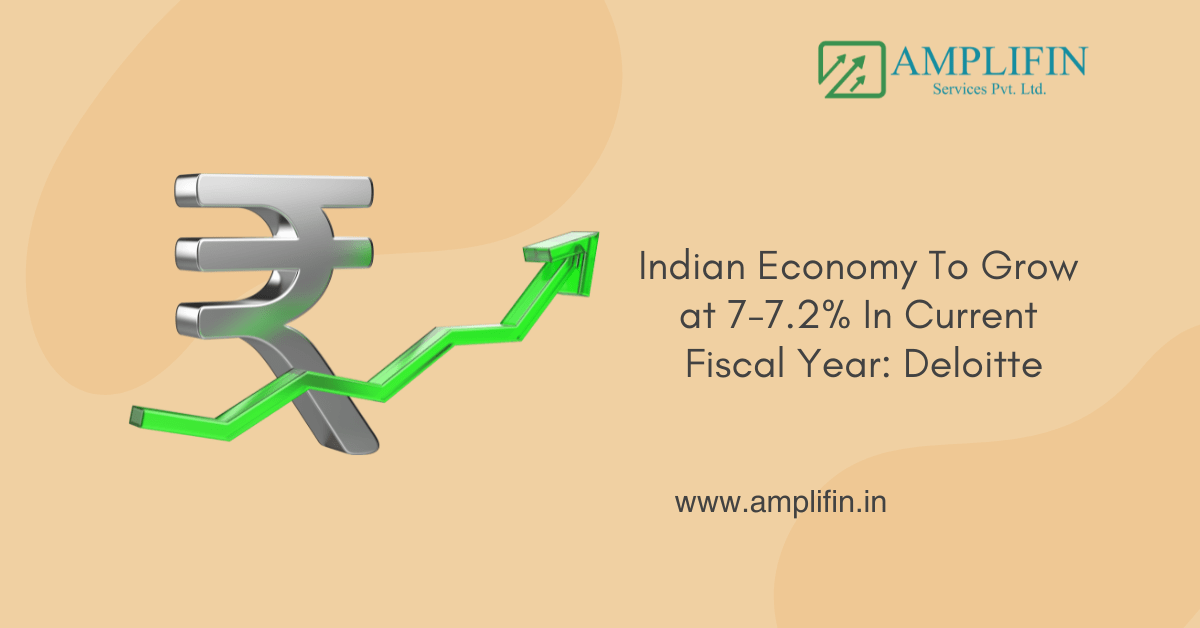Indian economy to grow at 7-7.2% in current fiscal year: Deloitte
India’s economic landscape is set for a remarkable transformation in the fiscal year 2025 (FY25), with projections indicating a robust growth rate of 7-7.2%. This optimistic outlook, supported by various economic indicators and expert analyses, signals a period of significant expansion and opportunities for the world’s fifth-largest economy. The growth in the second half of the fiscal year is especially noteworthy. Let’s delve into the factors driving this growth, the challenges ahead, and what it means for businesses, investors, and the average Indian citizen.

The Foundation of Growth: Economic Fundamentals and Policy Reforms
The projected growth rate of 7-7.2% for FY25 is not a mere coincidence but a result of strong economic fundamentals carefully nurtured through a series of domestic policy reforms. These reforms have created a stable and predictable business environment, encouraging both domestic and foreign investments across various sectors. This stability is noted in the India Economic Outlook.
One of the key drivers of this growth is the continuity in domestic policy reforms. The Indian government’s commitment to creating a business-friendly environment has been evident in recent years, with initiatives aimed at ease of doing business, streamlining regulations, and promoting foreign direct investment. This consistency in policy direction has instilled confidence in investors and businesses, laying the groundwork for sustained economic expansion.
Moreover, the Union Budget 2024-25 has introduced several initiatives focused on improving agricultural productivity, job creation for youth, and addressing the challenges faced by micro, small, and medium enterprises (MSMEs). These measures are expected to have a multifaceted impact on the economy:
- Boosting agricultural productivity will likely lead to increased rural incomes, stimulating consumer spending in these areas.
- Job creation initiatives for youth will help harness India’s demographic dividend, potentially increasing overall productivity and private consumption.
- Support for MSMEs is crucial as they form the backbone of the Indian economy, contributing significantly to employment and GDP.
Consumer Spending: The Engine of Economic Growth
A significant factor contributing to the projected 7-7.2% growth is the anticipated increase in consumer spending, particularly in rural areas. The Indian economy has long been driven by domestic consumption, and FY25 is expected to see this trend continue and strengthen.
Addressing the urban-rural consumer spending gap is a key focus area. As efforts to narrow this disparity take effect, it’s expected to unlock significant economic potential, driven by robust economic fundamentals. Rural consumers increasing their spending on discretionary goods and services will create a ripple effect throughout the economy, benefiting various industries and driving overall growth.
Interestingly, recent research indicates a broad-based shift in consumption patterns across India. There’s a noticeable trend towards increased spending on non-food and discretionary items, reflecting changing lifestyles and preferences. This shift is particularly pronounced in rural areas, where spending on discretionary durable goods (including automobiles, electric and electronic goods) is quickly catching up with urban areas.
The demand for processed food has also seen a significant uptick across most states, suggesting a shift towards ready-to-eat options. This trend is driven by rapid urbanization, increasing women’s participation in the workforce, and enhanced marketing and availability of these products.
Global Factors Influencing India’s Economic Trajectory
While domestic factors play a crucial role, global economic conditions also contribute significantly to India’s growth prospects. Several international factors are likely to benefit the Indian economy in FY25, driven by robust economic fundamentals:
- Reduced uncertainties in the US economic landscape are expected to have a positive impact on global markets, including India, as indicated in the August update. As one of the world’s largest economies, stability in the US often translates to improved conditions for emerging markets like India.
- The prospect of synchronous global growth within a low inflation regime is particularly favorable for India. This environment could lead to improved global liquidity conditions, which in turn may enhance capital flows into the Indian market.
- As central banks in the West ease their monetary policy stance, it’s expected to improve global liquidity conditions. This could drive higher investments, particularly in the private sector, further fueling economic growth.
Inflation Management and Monetary Policy
Effective inflation management has been a key focus of India’s economic strategy. The Reserve Bank of India’s efforts to curb inflation have played a crucial role in creating a stable economic environment conducive to growth, as highlighted in the August update.
The current fiscal year has seen a balanced approach to monetary policies, aimed at controlling inflation without stifling growth. This delicate balance has helped maintain investor confidence while ensuring that consumer spending power is not eroded by rising prices.
As we look toward FY25, the continuation of prudent monetary policies is expected to support the projected growth rate of 7-7.2%. By maintaining inflation within acceptable limits, the government and central bank aim to create an environment where businesses can plan for the long term and consumers feel confident in their spending decisions.
The Role of MSMEs in Driving Economic Growth
Micro, Small, and Medium Enterprises (MSMEs) are set to play a pivotal role in India’s economic growth story. These businesses form the backbone of the Indian economy, contributing significantly to employment and GDP.
The government’s focus on strengthening the MSME sector through various initiatives is expected to yield positive results in FY25. By improving access to credit, simplifying regulations, and promoting technological adoption, these policies aim to enhance the productivity and competitiveness of MSMEs.
As these enterprises grow and thrive, they are likely to contribute substantially to the overall economic growth, helping to achieve and potentially exceed the projected 7-7.2% expansion. The success of MSMEs will be particularly crucial in driving growth in rural areas and smaller cities, contributing to a more balanced and inclusive economic development.
Investment Climate and Private Sector Participation
The robust growth projection for FY25 is also underpinned by an improving investment climate and increased private sector participation. Deloitte India notes this trend in their report. The continuity in domestic policy reforms has created a more predictable and attractive environment for both domestic and foreign investors.
The private sector is expected to play a larger role in driving economic growth in the coming fiscal year. With improved global liquidity conditions and a stable domestic policy environment, private companies are likely to increase their investments in various sectors.
This increased private sector activity is anticipated to create more jobs, drive innovation, and contribute significantly to the overall economic expansion. The government’s initiatives to ease doing business and attract foreign direct investment are also expected to bear fruit, further boosting the investment landscape.
Rural Development and Its Impact on Overall Growth
The focus on rural development is a key aspect of India’s growth strategy for FY25. The projected growth rate of 7-7.2% takes into account the potential unleashed by initiatives aimed at boosting rural incomes and productivity.
Efforts to improve agriculture productivity, as outlined in the Union Budget 2024-25, are expected to have a significant impact on rural economies, which will grow at 7-7.2 per cent. By enhancing farmers’ incomes and creating more non-farm employment opportunities in rural areas, these initiatives aim to reduce the urban-rural divide and create a more balanced economic growth.
The ripple effects of rural development are likely to be felt across the economy. As rural incomes rise, it will lead to increased demand for various goods and services, benefiting industries beyond the agricultural sector and influencing private consumption patterns. This inclusive growth approach is central to achieving and sustaining the projected economic expansion, which is expected to grow at 7-7.2 per cent.
Challenges and Areas for Improvement
While the outlook for FY25 is undoubtedly positive, it’s important to acknowledge the challenges that lie ahead. Effectively addressing these issues will be crucial for realizing the full potential of India’s economic growth:
- Urban-rural consumer spending gaps: Despite progress, significant disparities remain between urban and rural spending patterns, affecting private consumption. Narrowing this gap is essential for creating a more balanced and sustainable economic growth.
- Inflation concerns: While inflation has been relatively well-managed, vigilance is required to ensure it doesn’t erode consumer purchasing power or hinder business growth.
- Employment generation: Creating quality jobs, particularly for the youth, remains a key challenge. The success of initiatives aimed at job creation will be crucial for harnessing India’s demographic dividend.
- Infrastructure development: Continued investment in infrastructure, both physical and digital, is necessary to support the projected growth and improve overall economic efficiency, as highlighted in the Deloitte India report.
- Skill development: Ensuring the workforce is equipped with the skills needed for a rapidly evolving job market is essential for maintaining long-term economic growth.
Conclusion: A Promising Outlook with Room for Optimism
As we look ahead to FY25, the Indian economy stands on the cusp of a significant growth phase. The projected growth rate of 7-7.2% reflects the country’s strong economic fundamentals, the impact of ongoing policy reforms, and favorable global conditions, according to the latest India Economic Outlook.
The focus on inclusive growth, with particular attention to rural development and MSME support, bodes well for creating a more balanced and sustainable economic expansion. The shift in consumer spending patterns, especially in rural areas, presents exciting opportunities for businesses across various sectors.
However, realizing this potential will require continued efforts from policymakers, businesses, and citizens alike. Addressing challenges such as the urban-rural divide, inflation management, and job creation will be crucial for achieving and potentially exceeding the projected growth rate.
As India navigates the complexities of the global economic landscape, its resilience and adaptability will be key assets. The coming fiscal year promises to be an exciting period of growth and transformation for the Indian economy, with far-reaching implications for businesses, investors, and citizens across the country.
In conclusion, the projected 7-7.2% growth rate for FY25 is not just a number – it’s a testament to India’s economic potential and a roadmap for a more prosperous future. As the country continues to build on its strengths and address its challenges, the coming years could mark a significant milestone in India’s journey towards becoming a global economic powerhouse.
